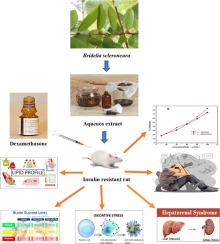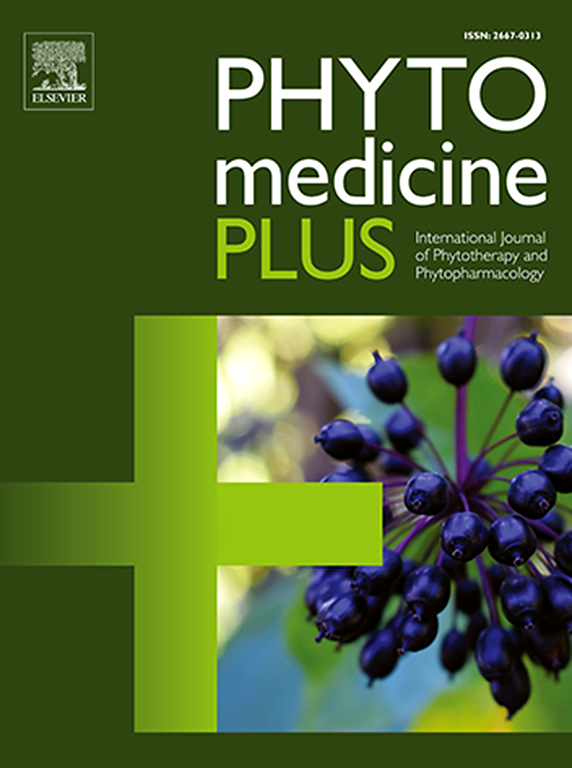Antidiabetic and antidepressant potentials of aqueous extract of Bridelia scleroneura Müll. Arg. root bark in a dexamethasone-induced insulin-resistant rat model
Q3 Pharmacology, Toxicology and Pharmaceutics
引用次数: 0
Abstract
Background
Bridelia scleroneura is a plant of the Euphorbiaceae family used in traditional medicine to treat diabetes mellitus and depressive psychoses. According to the literature, no antidiabetic or antidepressant studies have been conducted on B. scleroneura. The objective of this study was to evaluate the antidiabetic and antidepressant potential of aqueous extract of B. scleroneura root bark (AEBS) in insulin-resistant rats.
Methods
An in vitro antidiabetic study was conducted using α-amylase and α-glucosidase enzyme inhibition tests. For the in vivo study, 35 rats were divided into groups of 5 rats each and treated orally for 14 days with metformin (40 mg/kg), imipramine (10 mg/kg), and AEBS (62.5, 125, and 250 mg/kg). One hour later, dexamethasone (1 mg/kg) was administered subcutaneously to induce insulin resistance. To assess depression, forced swimming and sucrose preference tests were performed on days 1 and 14. Body weight, food and water consumption, glycemia, insulin levels, lipid profile, oxidative status, markers of renal and hepatic function, enzymes of carbohydrate metabolism, as well as glucogen, pro-inflammatory cytokines, and monoamine levels were assessed.
Results
AEBS inhibited the activity of α-amylase (IC50 = 79.31 ± 0.57 µg/mL) and α-glucosidase (IC50 = 71.25 ± 0.39 µg/mL). It also significantly decreased food and water consumption and the levels of glucose, insulin, total cholesterol, triglycerides, low-density lipoprotein, reduced glutathione, malondialdehyde, tumor necrosis factor-α, interleukins 1β and 6, total bilirubin, creatinine, and urea. AEBS (125 and 250 mg/kg) decreased the activities of alanine aminotransferase, aspartate aminotransferase, glucose-6-phosphatase, and fructose-1,6-diphosphate dehydrogenase and increased the activities of glucokinase, glucose-6-phosphate, catalase, and superoxide dismutase. AEBS significantly increased body weight and levels of glycogen, total protein, albumin, dopamine, and serotonin.
Conclusion
AEBS has inhibitory potential on the activity of α-amylase and α-glucosidase. It has hypoglycaemic, antidyslipidaemic, and antidepressant effects and protects organs against oxidative damage.

硬膜桥莲水提物的抗糖尿病和抗抑郁作用。参数。地塞米松诱导的胰岛素抵抗大鼠模型中的根皮
大戟是大戟科的一种植物,在传统医学上用于治疗糖尿病和抑郁症。根据文献,尚无针对硬脊膜杆菌的抗糖尿病或抗抑郁研究。本研究的目的是评价硬脊髓炎根皮水提物(AEBS)对胰岛素抵抗大鼠的抗糖尿病和抗抑郁作用。方法采用α-淀粉酶和α-葡萄糖苷酶抑制试验进行体外抗糖尿病研究。在体实验中,35只大鼠分为每组5只,分别给予二甲双胍(40 mg/kg)、丙咪嗪(10 mg/kg)和AEBS(62.5、125、250 mg/kg)口服14 d。1小时后皮下给予地塞米松(1 mg/kg)诱导胰岛素抵抗。为了评估抑郁,在第1天和第14天进行了强迫游泳和蔗糖偏好测试。评估了体重、食物和水的消耗、血糖、胰岛素水平、血脂、氧化状态、肾功能和肝功能指标、碳水化合物代谢酶、糖原、促炎细胞因子和单胺水平。结果saebs抑制α-淀粉酶(IC50 = 79.31±0.57µg/mL)和α-葡萄糖苷酶(IC50 = 71.25±0.39µg/mL)活性。它还显著减少了食物和水的消耗以及葡萄糖、胰岛素、总胆固醇、甘油三酯、低密度脂蛋白、还原谷胱甘肽、丙二醛、肿瘤坏死因子-α、白细胞介素1β和6、总胆红素、肌酐和尿素的水平。AEBS(125和250 mg/kg)降低了谷丙转氨酶、天冬氨酸转氨酶、葡萄糖-6-磷酸酶和果糖-1,6-二磷酸脱氢酶的活性,提高了葡萄糖激酶、葡萄糖-6-磷酸、过氧化氢酶和超氧化物歧化酶的活性。AEBS显著增加体重和糖原、总蛋白、白蛋白、多巴胺和血清素水平。结论aebs对α-淀粉酶和α-葡萄糖苷酶活性有抑制作用。它具有降血糖、降血脂和抗抑郁作用,并保护器官免受氧化损伤。
本文章由计算机程序翻译,如有差异,请以英文原文为准。
求助全文
约1分钟内获得全文
求助全文
来源期刊

Phytomedicine Plus
Medicine-Complementary and Alternative Medicine
CiteScore
3.70
自引率
0.00%
发文量
178
审稿时长
81 days
期刊介绍:
 求助内容:
求助内容: 应助结果提醒方式:
应助结果提醒方式:


